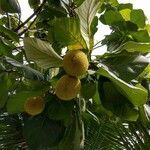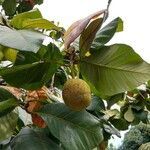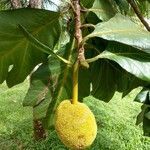Tree up to 25 m tall, evergreen. Leafy twigs 4-12 mm thick, ± densely brown strigillose to hispidulous, ± scabrous or hirsute, the long hairs with swollen bases, intermixed with much shorter hairs or not, drying brown; lenticels scattered. Leaves spirally arranged; lamina subcoriaceous (to chartaceous), entire, elliptic (to subrhombic) to obovate, 10-30(-55) by (6-)10-15(-30) cm, apex subacuminate to apiculate, base cuneate to subdecurrent, margin entire, repand, denticulate, or (unilaterally) lobate (when juvenile 3-lobed to pinnately incised with 1 or 2 pairs of lateral lobes); upper surface brownish hispidulous, on the main veins to strigillose, or hirtellous, ± scabrous; lower surface brownish (sub)hispidulous to puberulous, on the main veins to strigillose, or hirtellous, scabridulous; lateral veins 13-20 pairs, often branched or forked away from the margin, tertiary venation scalariform, prominent; petiole (1.5-)2-3 cm long, 3-4 mm thick, brown strigillose (to hirtellous), or hirsute, the epidermis persistent; stipules 1-5(-8) cm, brown strigillose to subhirtellous or to strigose, or hirsute, caducous. Staminate inflorescences axillary, solitary; peduncle (2.5-)3-13 cm long, brown appressedly puberulous to hispidulous or hirtellous to subhirsute, ± scabrous; head ellipsoid to obovoid to clavate, 4-9 by 2.5-3.5 cm; perianth tubular c. 1.8 mm long, the apex 2-lobed, minutely puberulous; stamen c. 2 mm long, anther 0.1-0.2 mm long; interfloral bracts peltate, the apical part 0.3-0.4 mm diam., yellowish puberulous. Pistillate inflorescences axillary, solitary; peduncle 5-14 cm long, densely brown appressedly puberulous to hispidulous, or hirtellous to subhirsute, ± scabrous; head ellipsoid to subglobose; perianth tubular, hispidulous or hispid, the apex ± convex; stigma simple; interfloral bracts peltate, the apical part 0.3-0.4 mm diam., yellowish puberulous. Infructescences subglobose, 8-15 cm diam., sometimes ± lobed, fruit-containing part 5.5-12 cm diam., covered with 8-12 mm long cylindrical apices of the perianths; fruits ellipsoid, c. 1 cm long.
More
A large tree. It grows 12 to 25 m high. The trunk is 40 cm across. The bark is smooth and dark grey. The twigs are 4-10 mm thick. They have ring like scars. The leaves are very rough and large. They are leathery. They can be entire or lobed. They are 16-50 cm long by 11-28 cm wide. They are hairy on both sides. The edges can be wavy. There are 12-15 pairs of secondary veins which curve and disappear near the edge of the leaf. The flower heads are solitary in the axils of leaves. The male heads are long and 40-90 ,, long by 25-35 mm wide. The fruit are very large and oval. It is 16 cm long by 13 cm wide. They are covered with soft fleshy spines. The fruit is yellow-green. The flesh of the fruit is white and very juicy and sweet with a smell. The fruit stalk is 5.5-14 cm long. The seeds are oval and 12 mm long by 8 mm wide. The fruit are edible.
A tropical tree. It suits the hot, wet tropical lowlands. It prefers a warm humid climate. It can be damaged by temperatures below 5°C. Occurs only in Mindoro, Mindanao and Basilan but apparently fairly common in Mindoro, Cotabato, Lanao, Davao, Zamboanga and Basilan in the Philippines. In Indonesia it grows in lowland forest and up to 1,000 m altitude. Brisbane Botanical Garden.
More
Secondary forests up to 1,000 metres altitude on sandy clay soils in Thailand. Evergreen forests.




